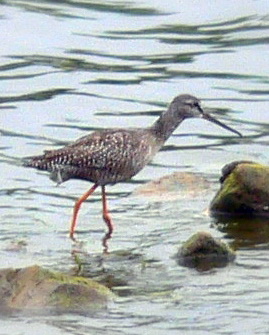Spotted Redshank (Tringa erythropus) - Wiki Spotted Redshank
From Wikipedia, the free encyclopedia
[Photo] Spotted Redshank (Tringa erythropus) juvenile. Polski: Brodziec ??niady. Date 19 August 2006. Author Wojsyl (http://commons.wikimedia.org/wiki/User:Wojsyl)
| Permission is granted to copy, distribute and/or modify this document under the terms of the GNU Free Documentation License, Version 1.2 or any later version published by the Free Software Foundation; with no Invariant Sections, no Front-Cover Texts, and no Back-Cover Texts. A copy of the license is included in the section entitled "GNU Free Documentation License". |
The
Spotted Redshank Tringa erythropus is a wader in the large bird family
Scolopacidae, the typical waders. It is an arctic bird, breeding across northern Scandinavia and northern Asia. It is a migratory species, wintering around the Mediterranean, tropical Africa, and tropical Asia, usually on fresh water. It is an occasional vagrant in Australia and North America.
It is 29-33 cm long. It is black in breeding plumage, and very pale in winter. It has a red legs and bill, and shows a white oval on the back in flight. Juveniles are grey-brown finely speckled white above, and have pale, finely barred underparts. It nests on open boggy taiga, laying four eggs in a ground scrape. The call is a creaking whistle teu-it (somewhat similar to the call of a
Roseate Tern), the alarm call a kyip-kyip-kyip. Like most waders, it feed on small invertebrates.
The
Spotted Redshank is replaced as a breeding bird further south by the
Common Redshank, which has a shorter bill and legs, and is brown and white above with some dark patterning below, becoming somewhat lighter-toned in winter.
Taxonomically, it forms a close-knit group with the
Greater Yellowlegs and the
Greenshank, which among them show all the basic leg and foot colours of the shanks, demonstrating that this character is paraphyletic (Pereira & Baker, 2005). These three species are the largest shanks apart from the
Willet, which is altogether more robustly built.
The
Spotted Redshank is one of the species to which the Agreement on the Conservation of African-Eurasian Migratory Waterbirds (AEWA) applies.
http://en.wikipedia.org/wiki/Spotted_Redshank| The text in this page is based on the copyrighted Wikipedia article shown in above URL. It is used under the GNU Free Documentation License. You may redistribute it, verbatim or modified, providing that you comply with the terms of the GFDL. |
